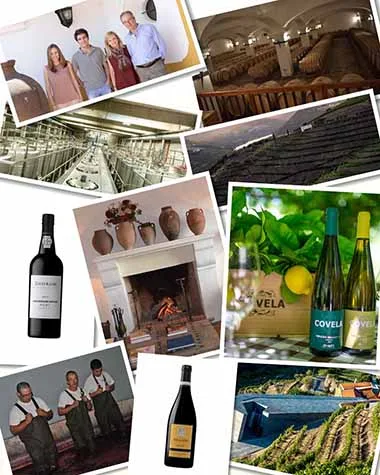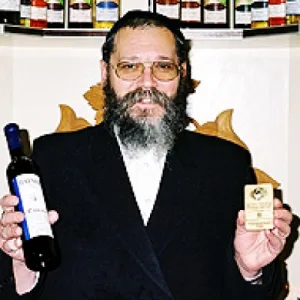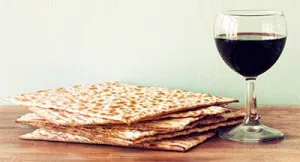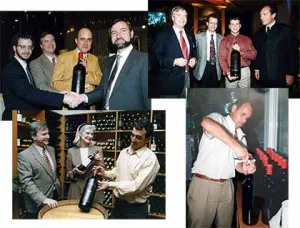I was born into the Spanish and Portuguese Jewish Community and even had my Bar Mitzvah at their Maida Vale Synagogue in London. We were sometimes known as Portuguese Jews, or even a lofty sounding ‘Jews of the Portuguese nation.’ These days Spanish & Portuguese Jews are sometimes referred to as ‘Western Sephardim.’ This is the nearest I came to Portugal.
I first came into contact with Portuguese wines in the 1980’s in London. The company group I worked for were UK agents for Aveleda Vinho Verde, Mateus Rose, then one the biggest selling brands in the world and Blandy’s Madeiras. I remember being told the rarely exported Vinho Verde Red was a great example of breaking taboos, because it was excellent with fresh, grilled sardines. The theory of this I took on board, and regularly used it as an example of how even a red wine could match with an oily fish. Of course, more famous were the Ports, the most famous fortified wines in the world. Apart from this, Portuguese wines were little known and the unpronounceable grape varieties took a back seat to the more accessible famous wine regions of Europe. I never visited Portugal and always considered the wines as something exotic to be mastered after the wines of Spain and Italy. Something like twenty years ago, I remember hearing that Portugal was the European country with the greatest unfulfilled potential and the ‘next big thing’. Sadly, the same description would not be out of place today.
Before Portuguese table wines came to Israel, Israelis were introduced to two Portuguese varieties. If the mountain will not come to Muhammed, then Muhammed must go to the mountain. Touriga Nacional and Tinta Cao were planted by the Golan Heights Winery. The Yarden 2T, a dry red wine, and Yarden T2, a sweet Port style fortified dessert wine, were the result.
Now, due to the drive of Jonathan Koren of Lotem Winery, the expertise of Wild Douro, a tourism specialist in Portugal, and the determined support of both the President of the Israel-Portugal Chambers of Commerce and the Economic Department of the Embassy of Portugal, a new marketing endeavor was born. This involves the twinning of Israeli and Portuguese wineries. The objective of this initiative is to develop tourism between the two countries, begin an academic cooperation and for winemakers to have a forum to share information. Seven Israeli wineries will participate: Lotem, Amphorae, Bat Shlomo, Dalton, Jezreel Valley, Tulip and Stern wineries.
Israel and Portugal do not have much in common, but there is one coincidence that places them together. In both the Wine Spectator and Wine Advocate, the wine tasting expert for Israeli and Portuguese wines are the same person. The two countries are bracketed together, along with Greece, amongst ‘others.’ Perhaps opposites attract, because both Israelis and Portuguese are fascinated by each other’s countries. The wine, food, culture and the feeling of being outsiders, seems to have resulted in a warm embrace between the two peoples. When I was invited by the Economic Attaché at the Portuguese Embassy to join a visit to learn about Portuguese food and wine, I jumped at the chance. The visit was hosted by Wild Douro with the assistance of El Al.
During the winter season to March 2020, there are up to three weekly El Al flights from Tel Aviv to Lisbon. The flights last between 5.30 to 6 hours and prices are reasonable. It is a great opportunity for the curious to discover the wines, regions and food of Portugal, and so much more.
As for my visit, I found a country rich in beauty, history and culture, that was incredibly advanced in wine tourism. Every winery I visited had a restaurant, and most also had accommodation. Service everywhere was stylish, respectful, correct and professional. Old world European. Portugal is something like the 10th largest wine producer in the world, yet it is a country of only 10 million people. Wines of Portugal, an umbrella organization, provides all the information one would want, in leaflets, a website and they even have tasting centers in Lisbon and Porto. Oh, that we would be so well equipped in Israel! It was clear this is a country of enormous variety of growing regions and wine styles. Furthermore, like Italy (and Greece) it has a large bank of untapped indigenous varieties. We travelled in the spirit to learn, sample and absorb and we discovered an enchanting country.
ALENTEJO The Alentejo region, towards the south west of the country, is flat with low rolling hills, hot, rural, and covered with cork oak forests, olive groves and wheat fields. I was so impressed that the region had its own central Wine Tourism office, with a colorful logo, offering tastings, explaining the terroir and grape varieties. Joao Portugal Ramos built his Vila Santa Winery in 1997. Their hall of marble lagars, (where they tread the grapes), with soft lighting was impressive, as was the vertical hydraulic Bucher press in the corner. Old and new technology coming together under one roof seemed very Portuguese. The open fire was homey and welcoming. All over Portugal I smelt the warm, sweet, spicy aromas from domestic fires burning wood. Like everywhere else, they had a restaurant. What was different here was they took us into the kitchen to prepare the dessert! Fortunately for those eating, I did not indulge myself and left the preparation of food to others. The winery has an original concept where they allow tourists to make and bottle their own blend, which was a great idea. Most of the wines in the region were blends, and the grape varieties were always in the background, often not even on the back label. So different from Israel. As for the specific wines, the Marques de Borba 2017, was round, full flavored and quite bold. Slightly ‘New World’ in taste. Their Duorum LBV Port 2014 was delicious.
We visited the graceful medieval village of Monsaraz and found the Ervideira Winery shop, situated in what was once a school class room! Most interesting here was the Conde D’Ervideira 2017, a blend of Touriga Nacional, Aragonez, Alicante Bouschet and Cabernet Sauvignon. The same wine was bottled with two different labels. One was aged in the winery cellar, and the other 30 meters under water. As gimmicks go, it was fairly original! If anything, the second bottle was smoother and more advanced, but there was not a lot in it.
LISBOA Then we travelled northwest of Lisbon, to what was once known as the Estremadura region. Quinta do Gradil, (Quinta is winery or estate), was once owned by the family of the Marquis of Pombal, an important figure in both wine regulation and politics. A striking outlook awaited us with the grand mustard yellow buiding, surrounded by red leaved vines in the autumn, striped with the green grass. This is a large mass market winery and Gradil is the premier label. Here I liked their fresh Maria de Carmo sparkling rose, the toasty Quinta do Gradil Brut and they also had an intense varietal Tannat balanced with Touriga Nacional. In the winery itself, the absolutely round, ball shaped concrete tank was a talking point.
BAIRRADA When we arrived to the Bairrada region, we were fortunate to visit the Coimbra University including the truly magnificent, gold covered, 18th century Joanina library. I noticed the importance of books to the Portuguese, including seeing book shops or libraries in unlikely places, like in a restaurant and even a church. Books strike a chord with me. How could they not with a mother and two brothers who are authors? I myself created wine libraries at both Carmel and the Golan Heights Winery, and played the leading role in developing the synagogue library at Kehilat Ra’anan – The Samueli Center in Ra’anana. I was impressed with the Portuguese attention to safeguarding the written word.
We were introduced to the wines of Bairrada at a quality food and wine pairing dinner at the Arcadas Restaurant in the luxury hotel Quinta Das Lagrimas. The wine of the evening was for me the Messias Baga 2017. It was medium bodied, with good black berry fruit, a rasping texture and pronounced acidity on the finish. A great food wine. This was more edgy, unique and was very much to my liking. I will remember the Baga grape variety.
DAO In the more central, hilly Dao region, the Quinta de Lemos was a winery I left with mixed feelings. Firstly, at their Mesa de Lemos Restaurant we received a Michelin standard lunch of outstanding originality. It was very high quality, prepared in an open kitchen in full view and served immaculately, in a beautiful and originally designed setting. During this meal we tasted seven wines. What I loved was the Portuguese habit of referring to each course or flight as ‘a moment.’ It was a memorable experience. However, my efforts to receive information on the winery and wine were notably less successful. Strange to invest so much in style and quality and yet not be geared to providing basic information. If I had to pick one wine it would be the Jaen 2013. Jaen is a grape variety almost unique to the Dao region. The wine was deep colored, with raspberry and floral notes and a concentrated ripe plum flavor. It had a good balancing acidity. Like so many Portuguese wines, it represents great value.
If the Mesa de Lemos and Quinta Das Lagrimas restaurants were the height of fine dining, the Restaurante De Raiz was a welcome return to home cooking. It is situated in the city of Viseu, the birth place of the Dao wine region. Unpretentious, homey, with authentic wholesome cooking, it is run by a young couple and even the parents were roped in to provide support front of house. Here we were fortunate to meet Patricia Santos. She is what I call a ‘touch and feel’ winemaker, with a fair bit of individuality, spontaneity and instinct in equal measure. Her Rosa da Mata 2017, from the Alfrocheiro grape variety, was a very individual signature. It had lashings of cherry berry fruit, a medium body in the mouth, and that refreshing acidity I am beginning to associate with the region.
THE DOURO Then we drove to the Douro, one of the most spectacular wine regions in the world. The views were breathtaking, with plunging terraced vineyards overlooking the winding river. Quinta Nova de Nossa Senhora do Carmo is a winery with an amazing landscape. We ate at the fine Conceitus Winery Restaurant, toured the Wine Museum. I particularly like the film showing how hard it was to navigate the barrels up the fast moving Douro River in times past. They would be taken from the winery to be stored and aged in the lodges of Vila Nova de Gaia, opposite Porto, before being shipped primarily to England, amongst other places. These days the wine is aged at the winery. The Grainha Reserve Red and White were each blends of over four varieties. They are fruity, full of flavor and both have a clean, well-balanced finish. Most interestingly from an Israeli point of view, is that Grainha is written clearly in Hebrew on the front label! Their Grande Reserva 2016 was a plush, rich velvety wine. This reminded us that table wines in the Douro are becoming more important, though the niche of Port still remains the calling card of Portuguese wine. A highlight was opening the excellent Quinta Nova Vintage Port 2000 with red hot tongs.
We were received by Francisco Ferreira of the Ferreira family Quinta do Vallado. The winery was built in 1716, and refurbished in the 2000’s. Here you will find in their words ‘history, modernity and discreet luxury’. Though this is one of the great Port families, this is one of the wineries leading the advance of Douro’s table wines. The refurbished schist covered winery hosted us for a tasting. The Prima Douro White 2018 was a dry Muscat, grapey, spicy, floral and refreshing. Apart from Alsace, there are not many dry Muscats about. The entry level red, a blend, was fruity, bright, full in flavor with a refreshing finish. Priced at the winery at €7.50, it emphasized the prices in Portugal, which by any measure were ridiculously low. I loved the Touriga Nacional 2017. It was fruity, with a hint of violets, soft yet mouth filling and refreshing. Fresh and bright, and very drinkable. My favorite wine was Vinha da Coroa 2017. This is a field blend with enchanting, sensual red fruit, a spiciness, elegance and a long complex finish. It was possibly my favorite wine of the whole visit. We also tasted a varietal Souzao, one of the parents of our own Argaman. It was very deeply colored with a harsh, unforgiving acidity. The 20 year old Tawny Port was superb. Rich and complex, with dried fruit notes that reminded me of brandy soused Christmas cake.
VINHO VERDE We moved up the Douro into the Minho region. Schist changed to granite. We were in Vinho Verde country. The Covela Winery is a British Brazilian partnership. It is in a most beautiful dreamy setting, surrounded by greenery, orchards, vineyards and forests. They produced two authentic Vinho Verdes, one made from Avessu grapes, the other made by Arinto, both from the 2018 vintage. The Avessu was more aromatic with a broader, minerally mouth feel, while the Arinto was sharper, with more citrussy notes. The Reserva 2015 was in a different style. It was an expressive, fuller bodied, slightly creamy blend of Chardonnay, Avesso and Arinto. It was probably the best white I came across in Portugal, but for quenching thirst, nothing beat the authentic and satisfying Avessu Vinho Verde.
The second Minho winery we visited was the Quinta da Lixa. A large commercial winery with a modern tasting room, where each place has its own spittoon cum sink, set into the table. They own the splendid Monverde ‘wine experience hotel’. Look out for the striking sculpture of 365 hanging wooden grape leaves. My favorite wine was their Alvarinho Reserva 2016. It had classic peach, apricot aromas, a full flavor and a long, steely finish.
The week ended with a visit to Amorim, the giant cork producer. It was interesting to see the scale, attention to detail and pursuit of quality. We learnt how after the cork tree matures, it may be harvested every nine years, a cycle that can continue for two hundred years.
When my son travelled to Portugal a couple of years ago, I told him to look out for the grilled sardines, remembering what I had been told in my wine youth. He sent back hilarious Whats App messages showing photos of shops with shelves groaning under the weight of tinned sardines. There was not a fresh sardine to be found. A fantasy that I had nurtured for thirty years, was ridiculed by reality. The sardine is a symbol of Portugal. On my visit I discovered tinned sardines, cuddly toy sardines, ceramic sardines and fridge magnet sardines. They were sold everywhere. I ate a great deal of salted cod, which we ‘enjoyed’ nearly every meal, but not a fresh sardine anywhere! In the Vinho Verde region, I did taste a Vinhao, which is their local name for Souzoa. Yes, it really would be perfect for grilled sardines. One half of the dream fulfilled. I will just have to time my next visit for when sardines are in season!
A wine industry veteran, Adam Montefiore has advanced Israeli wine for over 30 years. He has been referred to as the ambassador of Israeli wines. He is the wine writer for the Jerusalem Post.
www.adammontefiore.com
The writer was the guest of El Al Airlines and the Portuguese Embassy in Israel. The visit was hosted by Wild Douro. www.wild-douro.pt



















